 �
� �
�|
King Intermediate's Hawaiian Cultural Program |
At the King Intermediate School in Kane'ohe, Hawai'i, they have a wonderful program where they have dedicated the lower portion of the school property to promoting the education of students in Hawaiian culture. Buses full of children from other schools are brought to the site for guided tours. The tour takes the children around the grounds where they are shown all the different plants and trees that are indigenous to the islands. The tour guide explains what each planting is and what it traditionally was/is used for. As the tour progresses, you are serenaded by the birds and greeted with all the fragrances of the flowers grown there along with the breezes coming off of the bay.
Not only are there the areas of medicinal plantings, a coconut grove, fruit trees, flowers, etc., but there are the hula mound, imu (in ground oven), and the ground set aside for where the hale (house) will be established for the crafting of canoes. The children are excited and full of questions as they get a true hands on tour of things that affect their culture and daily lives in Hawai'i. Here they learn that the plants were used for food, medicine, clothing, decoration, dance implements, shelter, and canoes.
The students of the school are actively involved in all that goes on in the special program that was started by a gentleman they call "Pop". The grounds originally were overgrown with bushes and weeds. But the students of the school have devoted their time and energies to clearing the land, grading it, preparing the earth, and then putting in all the plants. People from all over the islands have donated the plantings for the program.
 �
�
Pop shown here with a picture done by one of his past
students who is now a professional artist
The school also has hosted groups from Guam, Amsterdam, Tahiti, Samoa, New Zealand, Mexico, etc. who have come to the islands to participate in the state's Merry Monarch festival held on the "big island" of Hawai'i. They have also been hosting the high school competitions every May for the past 9 years. It used to be held at the St. Louis Academy in Honolulu, but when the head of the event retired, it was moved to King Intermediate when Pop offered their hula mound. He went back to the principal of the school and told her of the great event that they would be hosting at their hula mound. So they set to work and built one.
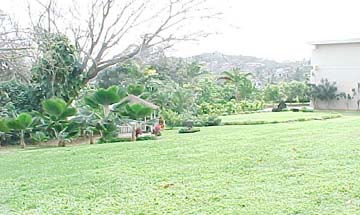 �
� 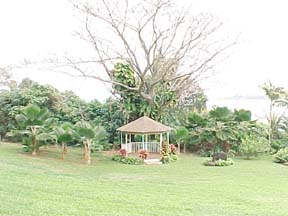 �
�
Hula Mound where the yearly High School Hula Competition takes place and the judges' stand/gazebo
One of the points of interest that can be found at the hula mound is made up of two large rocks. Pop explains the legend represented by the rocks that shows the spirit of womankind in the Hawaiian culture where they would do anything that it took to provide, protect, and support the family, even to the point of death. The story is that one day the men of a village left to attend the Makahiki games but had forgotten their offering. Upon returning to the village from picking limu (seaweed), the women saw that the offerings had been left behind. So the Chief's wife and daughter took the offering to the Makahiki grounds where women were not allowed. They quietly stole upon the grounds and placed the offering at the alter, but were unfortunately discovered by one of the guards who ordered them to stop. Instead, the woman and her daughter ran at which point the guards threw their spears killing both of the women. Upon hearing all the commotion, the Chief ran to see what was happening. There he saw his wife and daughter slain, and noticed the offering they had set at the alter that had been forgotten. The two women were turned to stone as a reminder to all women that they were not allowed to desecrate the Makahiki grounds. But more importantly, it was a tribute to all women as to their relentless devotion to their family, friends, and village.
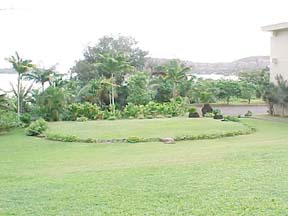 �
�
Mother and Daughter turned to stone
From the hula mound the tour moves to the "fishing village". That is where the canoe hale is to be built. The school has been given "seed money" of $35,000 to start this addition to the site. They have already received several requests for canoes to built once the facility has been completed as it will be the only other existing canoe hale in the state, the other one being located on the island of Hawai'i. The grounds are on a steep incline leading down to the sea. Consequently, there is much work to be done by the students in grading it in preparation for the construction that should commence as soon as the logs arrive from a neighboring island. The students were busy at the time of my visit moving all the rocks, dirt, etc., and getting the foundation stone walls built. It will be 60 feet by 60 feet. They will be using 10" diameter Ohia trees for the poles of the hale that are being sent from Hilo, Hawai'i. The roofing will be done with plywood topped by Pili grass. By law they must use nails, but they will also be binding it with rope, making the sennet from coconut husks. And from the land's end there will be a pier that will allow them access to Coconut Island. From there you move over to the fishing shrine/alter. That is where the offerings are left for a good catch.
 �
�
Fishing mound
Winding back up the hillside just a bit, you approach the imu site. There the wood is put in the bottom with the kindling first and then larger pieces of wood that provide the fuel to heat the lava rocks. Banana stalks are pounded well and then put over the red-hot rocks upon which the pig is laid. The pig is put in a chicken wire cage and red-hot rocks are placed inside the cavity of the pig before it is put into the imu. That is then covered with more banana stalks and finally burlap bags that have been soaked in water and squeezed out well that keeps the moisture in. Then the entire opening to the imu is then covered with tarp and mounded with dirt until no steam is seen escaping.
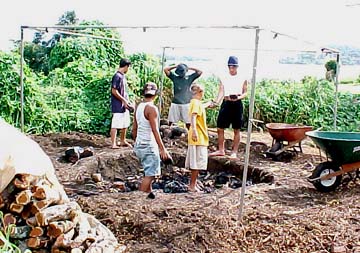 �
� 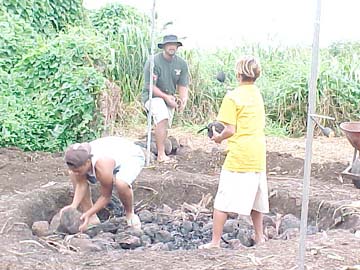 �
�
Students removing the imu stones after a weekend Kalua Pig fundraising sale
Then there is the flower garden where a multitude of species is grown that is used for the making of leis. There are multiple varieties of hibiscus, plumeria, ginger, and ti leaves among others grown in this part of the garden. Nearby is the medicinal garden where Pop explains the various uses of the different plants grown there.
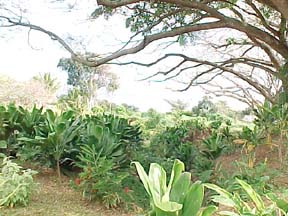 �
�
Ti Leaf and Ginger portion of garden
overlooking Kane'ohe Bay
The one thing that can not be cultivated in the same manner in the garden as all the sites they have built and plantings they have grown, is the wealth of knowledge, experience, and talent presented in the person that is Pop. He is a master Kumu Hula (keeper and teacher of the dance). The final thing he does on the tour is to teach the children a dance and translates the Hawaiian words of the song for the children so they understand what it is they are dancing to. Once the dance is completed, the children are led back to the top of the school property to their buses. Along the way we view all the murals painted on the outer walls of the school by the art students of the intermediate school. The murals are depictions of some of the Hawaiian legends, using other students as models for the people. Finally we reach the parking lot where the children depart well fed with a part of the Hawaiian culture that if not for programs such as the one at King Intermediate would be lost to them for all time.

Page created by:
Pualani Creations Hawai'iJanuary 31, 2000